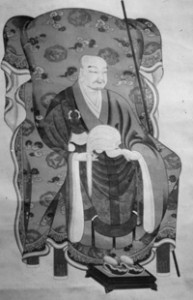Keizan Zenji was born in Fukui Prefecture, in 1267, and entered Eiheiji, under Koun Ejo, at the age of twelve; thereafter he studied under Tetsu Gikai of the same temple. Much of his life was spent in establishing temples, in different parts of Japan, until he became Chief Abbot of Daijoji, in Ishikawa prefecture, where he spent ten years teaching. In 1321, at the request of Joken-risshi, he became Chief Abbot of Shogakuji; he renamed this temple Shogaku-zan Sojiji. Sojiji, which was made an Imperial Prayer Temple under Emperor Go-Daigo (1318 – 1339), became one of the two head temples of the Soto Zen Church of Japan, ranking as equal with Eiheiji, and Keizan Zenji became the greatest of the Soto Zen Ancestors after Dogen Zenji. The main ikon of the Soto Zen Church shows Shakyamuni Buddha at the top, in the centre, with Dogen Zenji on His right hand and Keizan Zenji on His left, both being slightly below Him. Dogen is regarded as the father of Soto Zen and Keizan as its mother.
Before Keizan’s advent, Soto Zen had been confined to a few small monasteries, none of which were to be found in Kyoto, the spiritual centre of Japan at that time. As a result of Keizan’s genius, Soto not only flourished but became the largest of all the Buddhist churches, eventually rivalling the Shin Church in later centuries.
Reprinted with permission from Zen Is Eternal Life, by Reverend Master Jiyu-Kennett. Shasta Abbey Press, 1999.
For more on the life of Great Master Keizan, you can read this article from the OBC Journal.



